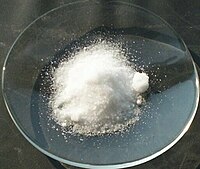MICA

The mica group of sheet silicate minerals includes several closely related materials having highly perfect basal cleavage. All are monoclinic with a tendency towards pseudo-hexagonal crystals and are similar in chemical composition. The highly perfect cleavage, which is the most prominent characteristic of mica, is explained by the hexagonal sheet-like arrangement of its atoms.
The word "mica" is thought to be derived from the Latin word micare, to glitter, in reference to the brilliant appearance of this mineral (especially when in small scales). Mica has a lamellar form with a shiny luster.
CALCITE

Calcite is a carbonate mineral and the most stable polymorph of calcium carbonate (CaCO3). The other polymorphs are the minerals aragonite and vaterite. It has a Mohs hardness of 3, a specific gravity of 2.71, and its luster is vitreous in crystallized varieties. Color is white or none, though shades of gray, red, yellow, green, blue, violet, brown, or even black can occur when the mineral is charged with impurities.
Calcite is transparent to opaque and may occasionally show phosphorescence or fluorescence. It is perhaps best known because of its power to produce strong double refraction of light, such that objects viewed through a clear piece of calcite appear doubled in all of their parts—a phenomenon first described by Rasmus Bartholin. A beautifully transparent variety used for optical purposes comes from Iceland, called Iceland spar.
SALTPETER
(Potassium nitrate)

Potassium nitrate is a chemical compound with the chemical formula KNO3. A naturally occurring mineral source of nitrogen, KNO3 constitutes a critical oxidizing component of black powder gunpowder. In the past it was also used for several kinds of burning fuses, including slow matches. Since potassium nitrate readily precipitates, urine was a significant source, through various malodorous means, from the Late Middle Ages and Early Modern era through the 19th century. Potassium nitrate is the oxidizing component of black powder. Before the large-scale industrial fixation of nitrogen through the Haber process, major sources of potassium nitrate were the deposits crystallizing from cave walls and the draining of decomposing organic material. Potassium nitrate is also used as a fertilizer, in amateur rocket propellant, and in several fireworks such as smoke bombs, in which a mixture with sugar produces a smoke cloud of 600 times their own volume. The ratio for smoke bombs using sucrose (powdered sugar) and potassium nitrate is 40(C12H22O11):60(KNO3). It can be used as is,or consolidated into a lump by mixing with water to make a paste and allowing to dry overnight.
(Please don't take the above as encouragement to try a practical experiment, and if you do, it came from Wikipedia, not me.)
ALABASTER, ECT.
http://upload.wikimedia.org/wikipedia/commons/thumb/0/00/Alabaster.whole.600pix.jpg/200px-Alabaster.whole.600pix.jpg
Alabaster (sometimes called satin spar) is a name applied to varieties of two distinct minerals: gypsum (a hydrous sulfate of calcium) and calcite (a carbonate of calcium). The former is the alabaster of the present day; the latter is generally the alabaster of the ancients.
The two kinds are readily distinguished from each other by their relative hardnesses. The gypsum kind is so soft as to be readily scratched by a finger-nail (Mohs hardness 1.5 to 2), while the calcite kind is too hard to be scratched in this way (Mohs hardness 3), though it does yield readily to a knife. Moreover, the calcite alabaster, being a carbonate, effervesces on being touched with hydrochloric acid, whereas the gypsum alabaster, when so treated, remains practically unaffected.
Selenite, satin spar, desert rose, and gypsum flower are the four crystalline varieties of gypsum. All gypsum varieties are very soft mineral (hardness: 2 on Mohs Scale) composed of calcium sulfate dihydrate (meaning has two molecules of water), with the chemical formula CaSO4·2H2O. Selenite can be scratched with a fingernail.


ANHYDRITE

Anhydrite is a mineral - anhydrous calcium sulfate, CaSO4. It is in the orthorhombic crystal system, with three directions of perfect cleavage parallel to the three planes of symmetry. It is not isomorphous with the orthorhombic barium (baryte) and strontium (celestine) sulfates, as might be expected from the chemical formulas. Distinctly developed crystals are somewhat rare, the mineral usually presenting the form of cleavage masses. The hardness is 3.5 and the specific gravity 2.9. The colour is white, sometimes greyish, bluish or purple. On the best developed of the three cleavages the lustre is pearly, on other surfaces it is vitreous. When exposed to water, anhydrite readily transforms to the more commonly occurring gypsum, (CaSO4·2H2O) by the absorption of water. Anhydrite is commonly associated with calcite, halite, and sulfides such as galena, chalcopyrite, molybdenite and pyrite in vein deposits.
ALUNITE

Alunite, or alumstone, is a mineral that was first observed in the 15th century in Monti della Tolfa, north to Rome, where it was mined for the manufacture of alum. First called aluminilite by J.C. Delametherie in 1707, this name was contracted by François Beudant in 1824 to alunite.
Distinct crystals of alunite are rarely found in cavities in the massive material. Alunite crystallizes in the hexagonal system with crystals forming trigonal pyramids that resemble rhombohedra with interfacial angles of 90 50', so that they resemble cubes in appearance. Minute glistening crystals have also been found loose in cavities in altered rhyolite. Alunite varies in color from white to yellow gray. The hardness is 4 and the specific gravity is between 2.6 and 2.8. The mineral is a hydrated aluminium potassium sulfate, KAl3(SO4)2(OH)6. Sodium substitutes for potassium and when high in sodium it is called natroalunite. It is insoluble in water or weak acids, but soluble in sulfuric acid. Jarosite is an iron analogue in which Fe3+ replaces the aluminium. It occurs as a secondary mineral on iron sulfate ores.
NOTE:
There are only 7 images in this post. Why? Because of the special bonus mineral that gets it's own.

 Author
Topic: Learning about all our Dwarf Fortress Rocks! (Read 53347 times)
Author
Topic: Learning about all our Dwarf Fortress Rocks! (Read 53347 times)

